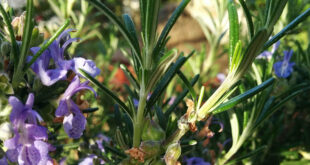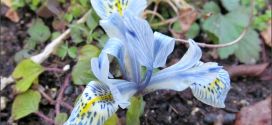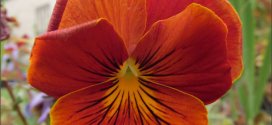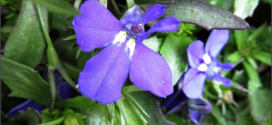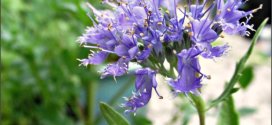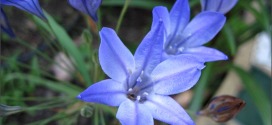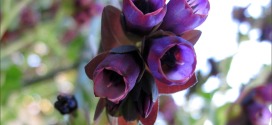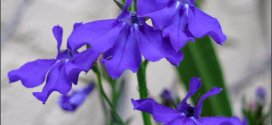Rosemary is one of those wonderful herbs that makes a beautiful ornamental plant as well as a welcome culinary seasoning. Its Latin name, Rosmarinus officinalis , means “dew of the sea” and rosemary is most closely associated with the cooking of the Mediterranean area. However you don’t need perfect sunshine, sea mist or even a never ending summer to successfully …
Read More »Tag Archives: blue
Pacific Coast Iris
Our native Pacific Coast irises include 11 species that produce flowers in shades of white, yellow, pink, lavender, even USC-worthy cardinal and gold. Most of the Pacific Coast irises, or Pacificas, sold in California are from a single species, Iris douglasiana. To learn about the foliage and flower distinctions behind each species classification, there is no better source than the …
Read More »Pansy
Pansy, Viola x wittrockiana Family: Violaceae (vy-oh-LAY-see-ee) (Info) Genus: Viola (vy-OH-la) (Info) Species: x wittrockiana (wit-rok-ee-AH-na) (Info) Category: Annuals Tropicals and Tender Perennials Height: under 6 in. (15 cm) 6-12 in. (15-30 cm) Spacing: 6-9 in. (15-22 cm) Hardiness: USDA Zone 7a: to -17.7 °C (0 °F) USDA Zone 7b: to -14.9 °C (5 °F) …
Read More »Lobelia
Blue Lobelia, Lobelia siphilitica Family: Campanulaceae (kam-pan-yew-LAY-see-ee) (Info) Genus: Lobelia (low-BEE-lee-a) (Info) Species: siphilitica (sigh-fy-LY-tih-kuh) (Info) Category: Perennials Height: 24-36 in. (60-90 cm) Spacing: 18-24 in. (45-60 cm) Hardiness: USDA Zone 4a: to -34.4 °C (-30 °F) USDA Zone 4b: to -31.6 °C (-25 °F) USDA Zone 5a: to -28.8 °C (-20 °F) USDA …
Read More »Spirea – Blue Mist
The “Blue Mist” spirea (Caryopteris x clandonensis “Blue Mist”) provides garden color from midsummer through fall. Also called blue beard and blue spirea, the plant earns its names from the fragrant, purple-blue flower spikes that adorn it for most of the summer season and that attract bees and butterflies. The low-maintenance deciduous shrub grows to only 2 or 3 feet …
Read More »Squill
Siberian squill, grown from a small bulb, is probably the most familiar of the scillas. The plants themselves don’t get much taller than about 6 inches, but they make up for their diminutive size by spreading out and blooming profusely. The tiny bulbs grow and multiple easily and the plants will also self-seed, making scilla a perfect choice for naturalizing.
Read More »Cerinthe – Blue Honeywort
Honeywort, Blue Shrimp Plant, Blue Wax Flower, Cerinthe major ‘Purpurascens’. This plant is attractive to butterflies, birds, and bees. The word “honeywort” means a plant that produces a lot of honey. Average Water Needs; Water regularly; do not overwater Family: Boraginaceae Genus: Cerinthe (ser-IN-thee) (Info) Species: major (MAY-jor) (Info) Cultivar: Purpurascens Additional cultivar information: (aka Purpurescens) Synonym:Cerinthe major …
Read More »Salvia – Blue Hills
Salvia × sylvestris ‘Blauhügel’ BLUE HILL. This salvia cultivar is a compact plant which typically grows only to 20″ tall. Features densely-flowered, spike-like racemes of pure blue flowers which bloom in June and continue throughout the summer. Flowers are attractive to bees and butterflies. A mint family member which has narrow, dark green, basal leaves (to 5″) and smaller stem …
Read More »Sea Lavender
Sea Lavender. Herbaceous Perennial Flower Also known as Statice, Statice Plumbago Limonium latifolium Plumbaginaceae Family Synonym: Statice latifolia Tolerant of droughty soil, this sun-loving perennial delivers dense clouds of blue to pink-purple flowers rising above dark green basal rosettes. Delicate and airy in the garden and as a dried flower. Sunlight: full sun Shade from hot …
Read More »Blue Potato Bush
The fragrant flowers of Blue Potato Bush (Lycianthes rantonnetii, also known as Solanum rantonnetii, and Paraguay nightshade), provide a focal point to a tropical or cottage garden. Surrounded by other sun-loving tropical and subtropical perennials, annuals and bulbs, the large shrub blooms year-round in frost-free gardens. Native to Argentina and Paraguay, the blue potato bush is hardy in U.S. Department …
Read More »